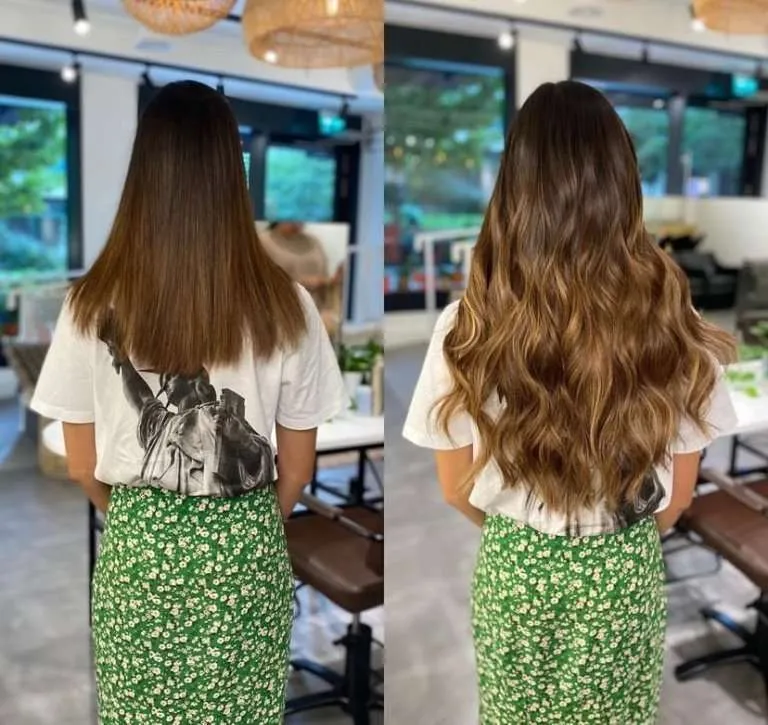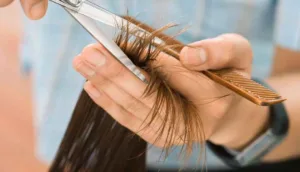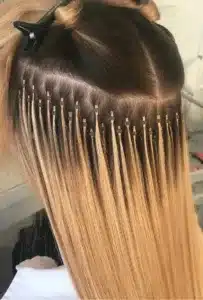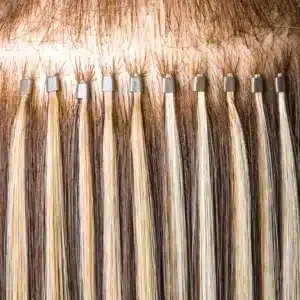Clients love great hair. You want results that last. Wrong expectations waste money and time. Clear replacement rules protect profit and client trust.
Most extensions follow simple ranges: synthetic 1month, nonremy human 2–3 months, remy hair 3–6 months, and premium full cuticle 12–18 months with proper care. Wear time also depends on method, daily maintenance, and lifestyle.

You will see surface signs, core causes, daily habits that shorten life, stylist benchmarks, care systems that double lifespan, and realistic costs. Use this as your salon playbook.
How often do hair extensions need to be replaced?
Clients ask for a number. I give a range, then I adjust to hair grade, method, and care. Clear timelines prevent arguments later.
Benchmarks by hair grade
- Synthetic fibers: Good for short runs, events, or backup looks. Not heat friendly. Shine reads artificial on camera. Expect 4 weeks before frizz and tangles win.
- Nonremy Human hair : Better finish and heat styling. Average 2–3months with proper care.
- Remy Hair:Hair cuticles in same direction, less tangle. 3–6months for clients who follow rules.
- Full cuticle (single donor): Highest durability. Holds curl pattern. Resists matting. 12–18 months with correct maintenance and timely services.
Benchmarks by method (wear cycle ≠ material lifespan)
| Method | Service cycle | Typical replacement of the hair |
|---|---|---|
| Tape-ins | Move-up every 6–8 weeks | Replace hair when fiber dries or splits; full cuticle reuses 3–6 cycles |
| Keratin bonds | Wear 3–5 months | Replace at each removal; hair not reusable |
| Sewn-in wefts | Tighten/shift 6–10 weeks | Replace when ends thin; full cuticle lasts multiple installs |
| Beaded (I/Nano) | Retighten 6–8 weeks | Replace when slippage and wear persist |
| Clip-ins | Day use only | Replace when wefts thin or coating lifts |
Decision rule
If the fiber looks tired after a proper cleanse, chelation, and deep condition, it is time. If the bond fails early while fiber looks healthy, adjust products, technique, or schedule—not the hair.
What surface indicators show it is time to replace extensions?
You can see trouble before clients feel it. Do not wait. Early action saves the install and your brand.
Watch for tangling, matting, dryness, split or cloudy ends, color fade that will not tone, bond slippage, or persistent odor after a deep cleanse.
Dive deeper
The visible checklist
- Tangles that return fast: Cuticle wear increases friction. Detangles do not hold for a day.
- Matting at rows or bonds: Shed natural hair traps inside attachments. Removal gets harder.
- Dry, squeaky ends: Masks help for one wash only. Ends feel hollow.
- White fuzz at tips: Friction breaks fiber; ends bloom and catch.
- Permanent warmth or brass: Chelation and toner fail to neutralize. Pigment support is gone.
- Edge-lift on tapes: Adhesive contaminated by oils or sunscreens. Clean retape fails.
- Odor after wash: Sweat and product built up inside bonds and wefts.
Troubleshoot or replace? (quick table)
| Symptom | Try first | Replace if… |
|---|---|---|
| Tangling | Chelate + protein then moisture | Returns within 24–48 hours |
| Matting | Careful section-by-section removal | Mat returns after reset |
| Dry ends | Trim + lipid-light leave-in | Ends still squeak and snap |
| Brass | Chelate + vitamin C + tone | Color shifts back in days |
| Slippage | Clarify + retape/retighten | Slips again in 1–2 weeks |
Root cause thinking
Surface signs are the result, not the cause. Ask: did products contain oils near bonds? Did client swim without rinsing? Did they sleep wet? Fix behavior; replace only when fiber can no longer recover.

Why does raw hair material decide lifespan?
Material is the foundation. Processing either protects that foundation or destroys it. I choose the foundation first, method second.
Full cuticle hair lasts longest. Remy lasts well with care. General human hair is mid-range. Synthetic is short-term. The difference shows after heat, sun, and weeks of wear.
Material stack explained
- Synthetic: Plastic-based fibers shaped to hold a preset style. Water and heat expose limits. Cuticles do not exist; friction rises over time.
- General human hair: Mixed sources. Some cuticle loss in acid baths. Looks good new. Longevity depends on post-processing oils that wash out.
- Remy/Virgin: Collected root-to-tip. Cuticles mostly aligned. Less acid, more gentle lifts. Better aftercare response.
- Full cuticle, single donor: Intact cuticles, aligned in one direction. Minimal chemistry. Strong cortex. Predictable color response.
Processing tells the truth
Harsh acid opens or strips cuticles. Heavy silicone coats hide damage until they rinse out. Gentle processing keeps scales intact. Extensions then behave like healthy hair, not coated fiber. That is why premium costs less over time.

Which daily habits shorten extension lifespan?
Daily habits set the clock. Small mistakes add up. Good routines add months.
Sweat, swimming, sleeping wet, sun, heat tools, and the wrong products all cut lifespan. Fix them and you double value without changing hair grade.
High-friction moments
- Workouts: Sweat plus salt lifts cuticles and softens tapes. Solution: scalp-friendly cleanse, full root dry, loose braid.
- Swimming: Chlorine and salt dehydrate and discolor. Solution: pre-wet, mid-length conditioner shield, rinse immediately, chelate weekly.
- Sleeping: Wet hair mats. Cotton drags. Solution: dry roots, silk pillowcase, low braid.
- Sun + SPF: UV dries fiber; some sunscreens stain blondes and loosen bonds. Solution: mineral SPF near hair, hat, fast rinse.
Heat and product
- Flat irons at bonds: Keratin softens. Tapes lift. Keep heat off attachments.
- Heavy oils and aerosols at scalp: Edge lift and dust collection. Pick water-based creams, mid-length application only.
Behavior → Impact → Fix (table)
| Behavior | Impact | Fix |
|---|---|---|
| Sleeping wet | Matting | Dry fully; braid |
| No rinse after swim | Brass/dryness | Fresh-water rinse; chelate weekly |
| Oil near tapes | Slippage | Keep products off bonds |
| Daily 400°F iron | Split ends | Lower heat + protectant |
| Rare brushing | Knots at nape | Loop-brush 2–3× daily |
What do expert stylists recommend for replacement timing?
Pros align service cycles with fiber reality. We watch the calendar and the hair. We never guess.
We schedule move-ups, tightenings, and removals by method. We replace hair when fiber health says so, not only when the calendar does.
Benchmarks by method (pro cadence)
- Tape-ins: Move-up every 6–8 weeks. With full cuticle, reuse 3–6 cycles if ends stay healthy. Replace when trims cannot restore slip and shine.
- Keratin bonds: Wear 3–5 months. Remove on time to protect natural hair. Replace hair each cycle; pre-bond hair is single-use.
- Sewn-in wefts: Shift/tighten 6–10 weeks. Replace when the hem thins or the fiber feels hollow after a deep treatment.
- Beaded (I/Nano): Retighten 6–8 weeks. Replace when rotation and slip persist despite correct bead size and technique.
- Clip-ins: Clean and rest between uses. Replace when weft stitching loosens or fiber coating wears.
Triage questions I ask at checks
1) Does hair bounce back after chelation + protein + moisture?
2) Do trims remove roughness without killing shape?
3) Are bonds clean and secure after a proper clarify?
4) Does the client follow the plan?
If the answer is “no” twice, I schedule replacement.
Team workflow
We photograph ends, track grams installed, log product use, and pre-book next service. Data makes the replacement talk easy and fair.

How do we maintain extensions to prolong life?
Maintenance is the cheapest upgrade. It turns a 6-month plan into 12. It keeps reviews five-star and returns low.
Use a simple system: gentle wash, smart condition, full dry at roots, safe styling, and scheduled resets. Tools matter less than habits.
Weekly system
- Wash 2–3× weekly: Sulfate-free shampoo. Massage scalp lines gently. Rinse long.
- Condition mids–ends only: Keep slip away from bonds. Add a light leave-in.
- Chelate 1× weekly during swim/travel/hard water. Follow with moisture mask.
- Dry roots fully: Damp bonds invite residue. Aim nozzle along the row, not into it.
Daily system
- Brush 2–3×: Loop brush. Hold roots. Ends → mids → roots.
- Sleep prep: Dry hair. Low braid. Silk pillowcase.
- Heat: Under 180°C/350°F for mids–ends. Keep tools off attachments.
Do / Don’t table
| Do | Why | Don’t | Why |
|---|---|---|---|
| Water-based leave-ins | Hydrate without bond slip | Heavy oils at scalp | Tape lift |
| Mineral SPF near hair | Lower stain risk | Aerosol SPF on part | Bond coating |
| Trim ends on schedule | Remove friction points | Skip trims | Splits spread |
Service checklist (printable)
Intake photo → Clarify/Chelate → Protein/Moisture balance → Trim/polish → Bond check → Education → Pre-book. Simple and repeatable.
How should salons budget for replacement costs?
Great hair is an asset. Plan for hair cost, chair time, color finishing, and maintenance. Quote the full picture.
Prices vary by market, grams, and grade. Full cuticle costs more at first but less per wear cycle.
Typical ranges (guidance, not rules)
| Method | Hair cost (grade dependent) | Install/Service | Notes |
|---|---|---|---|
| Clip-ins | $150–$1,200+ | DIY or $100–$300 styling | Keep multiple textures |
| Tape-ins | $300–$2,000+ | $250–$800 per move-up | Replace tapes; reuse hair if healthy |
| Keratin bonds | $800–$4,000+ | $600–$3,000+ install | Replace hair each cycle |
| Sewn-in wefts | $300–$3,000+ | $300–$1,500+ | Tighten every 6–10 weeks |
| Beaded (I/Nano) | $400–$2,500+ | $250–$900 retighten | Bead size and liner matter |
Cost levers you control
- Material: Full cuticle lasts 2–4×. Cost per month drops.
- Grams: Map density; avoid over-weighting small heads.
- Color: Pre-tone bundles to reduce chair time later.
- Care retail: Sell chelating shampoo and silk kits; they reduce replacement frequency.
Quote format that builds trust
Line-item the hair, installation, color finish, and maintenance plan. Add an estimate for future move-ups or removals. Clients respect clear math.

My opinion
I replace extensions when care no longer restores fiber and when bonds stay unstable after correct resets. I never chase one more cycle at the cost of natural hair health. Full cuticle hair, precise grams, and strict aftercare make replacements rare, predictable, and profitable for both salon and client.
FAQ
How often should I replace tape-in hair extensions?
Replace the hair when ends stay rough after trims and treatments. Many full cuticle sets last 3–6 move-ups; tapes change every service.
How often should keratin bonds be replaced?
Every cycle. Keratin-tipped strands are single-use. Wear 3–5 months, then remove and install fresh hair.
Do I replace wefts or just retighten?
Retighten every 6–10 weeks. Replace wefts when hems thin or fiber feels hollow after a deep reset.
Can I extend life with treatments instead of replacing?
Yes—chelation, protein, moisture, and trims can add months. If hair fails to bounce back, replace.
Why do my extensions tangle suddenly at month three?
Silicone coatings from processing have rinsed off. If material is mid-grade, friction rises. Upgrade material or adjust care.
Do blondes need faster replacement?
Often yes. Lightened fiber is more porous. Strict UV and swim care help.
Can I recolor old extensions to get one more cycle?
You can tone, not over-lift. If integrity is low, color will not fix feel. Replace.
What shortens lifespan the most?
Sleeping wet, oil near bonds, no rinse after swim, and high heat daily.
How do I know it is the bond, not the hair?
If fiber looks and feels good after reset but slips return fast, review products, technique, and schedule. The hair may still be fine.
Should I store retired hair?
Yes. Clean, dry, braid, and store in a breathable bag. You can reuse healthy wefts for photoshoots or partial volume.
Is full cuticle worth the higher price?
Yes. Cost per wear is lower. Finish stays premium. Maintenance is easier.
How do I talk replacement with clients?
Show before/after of the reset, feel the ends together, and review the log. Facts remove friction.
Conclusion
Replace when fiber health and bond stability do not recover after proper resets. Choose full cuticle hair, enforce care, and schedule services on time to protect results and profit.





